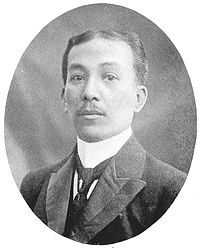
Back فيليپ اجونسيلو ARZ Felipe Agoncillo BCL Felipe Agoncillo Catalan Felipe Agoncillo German Felipe Agoncillo Spanish Felipe Agoncillo French Felipe Agoncillo Dutch ਫੇਲਿਪ ਐਗਨਸ਼ਿਲੋ Punjabi Агонсильо, Фелипе Russian Felipe Agoncillo Tagalog
Felipe Agoncillo y Encarnación | |
|---|---|
 A portrait of Don Felipe Agoncillo | |
| Secretary of Interior | |
| In office 1923–1925 | |
| Appointed by | Leonard Wood |
| Preceded by | Jose P. Laurel |
| Succeeded by | Honorio Ventura |
| Member of the Philippine Assembly from Batangas's 1st district | |
| In office 1907–1909 | |
| Preceded by | Post established |
| Succeeded by | Galicano Apacible |
| Personal details | |
| Born | Felipe Agoncillo y Encarnación May 26, 1859 Taal, Batangas, Captaincy General of the Philippines |
| Died | September 29, 1941 (aged 82) Manila, Philippine Commonwealth |
| Resting place | Santuario del Santo Cristo, San Juan, Metro Manila |
| Spouse | Marcela Mariño |
| Children | 6 "See children"
Gregoria Agoncillo (1889–1981) Lorenza Agoncillo (1890–1972) Eugenia Agoncillo (1893–1970) Maria Luisa Agoncilo (1894–1897) Marcela Agoncillo (1900–1995) Maria Agoncillo (1906–1945) |
| Parent(s) | Ramón Agoncillo Gregoria Encarnación |
| Alma mater | Ateneo de Manila |
| Profession | Lawyer Diplomat |
| Known for | His legacy as the first Filipino diplomat. |
Don Felipe Agoncillo y Encarnación (May 26, 1859 – September 29, 1941) was the Filipino lawyer representative to the negotiations in Paris that led to the Treaty of Paris (1898), ending the Spanish–American War and achieving him the title of "outstanding first Filipino diplomat."[1]
As a family friend and adviser of General Emilio Aguinaldo[2] and General Antonio Luna[3] during the critical times of the revolution, Agoncillo has been active in participating during that era especially when he presided over the Hong Kong Junta—a group of Filipino exiles who met to plan for future steps in achieving independence.[4] His greatest contribution to Philippine history was when he was assigned to negotiate with foreign countries to secure the independence of the country. This was considered the most important assignment given by a General.[5]
- ^ Ty, L.O. (1979). "Examiner". L.O. Ty. Retrieved November 29, 2007.
{{cite journal}}: Cite journal requires|journal=(help). - ^ Agoncillo, Teodoro A. (1974). Introduction to Filipino History. Quezon City, Philippines: GAROTECH Publishing. p. 139. ISBN 971-10-2409-8.
- ^ Agoncillo, Teodoro A. (1974). Introduction to Filipino History. Quezon City, Philippines: GAROTECH Publishing. p. 164. ISBN 971-10-2409-8.
- ^ Agoncillo, Teodoro A. (1974). Introduction to Filipino History. Quezon City, Philippines: GAROTECH Publishing. p. 141. ISBN 971-10-2409-8.
- ^ Agoncillo, Teodoro A. (1974). Introduction to Filipino History. Quezon City, Philippines: GAROTECH Publishing. p. 155. ISBN 971-10-2409-8.
© MMXXIII Rich X Search. We shall prevail. All rights reserved. Rich X Search